Extreme weather events, drought, wildfire, torrential rains, tornadoes, hurricanes, attributable to human-caused global warming, are costing society and insurers bilions of dollars worldwide. Mark Reynolds from Citizens Climate Lobby argues it is time for a carbon fee and dividend to even the market for fossil fuels and encourage clean renewable energy alternatives.
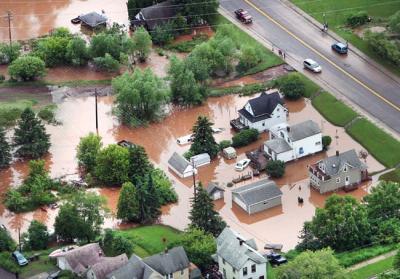
Who Pays the Price of Fossil Fuel Addiction: Drought, Wildfires, Torrential Rains, Tornadoes, Hurricanes?
In Duluth, Minn., the bar tab at Club Fossil Fuel came to $100 million.
Never heard of Club Fossil Fuel? It’s the most popular franchise on the planet, everyone’s favorite watering hole for well over a century, because the addictive libations — coal, oil and gas — are relatively cheap. Cheap, that is, until you factor in the hidden costs, like asthma and other respiratory diseases from air pollution or the military costs to secure our supplies of oil from the Middle East.
And now global warming, caused by emissions of greenhouse gases from fossil fuels, is adding to the bill in the form of floods, droughts and other extreme-weather events that are becoming more frequent and intense in a warming world.
Those warmer temperatures, scientists tell us, are “juicing” the atmosphere — literally — because warmer air holds more water. What goes up, of course, eventually comes down, and in Duluth what came down was nearly 10 inches of rain in a day and a half that caused historic flooding. Damage to roads, utilities and parks will take an estimated $100 million to repair, a hefty sum for a city of 89,000.
Floods are nothing new, of course. Just ask Noah. What is new is that climate change has loaded the dice and increased not only the odds of floods occurring, but also the severity of those floods.
And floods aren’t the only item being added to the bill at Club Fossil Fuel.
From Common Dreams: Due to extreme drought conditions and record heat waves across the country, corn yields are projected to be the lowest in nearly a decade, according to the U.S. Department of Agriculture. The statistics have also sparked concern over food prices in the near future.
The USDA expects that this year’s corn crop will average 146 bushels an acre, a 20 bushel decrease from its last estimation.
“Monday, Tuesday and Wednesday we had 108F. It just pretty much fried the corn,” David Kellerman, a farmer in southern Illinois, told the Associated Press.
The 2011 State of the Climate report by the National Oceanic and Atmospheric Administration (NOAA) and the American Meteorological Society (AMS) found: Warm temperature trends will continue, with greenhouse gas levels climbing. The Arctic Sea ice shrank to its second smallest “summer minimum” extent on record during 2011, as older ice (four to five years old) reached a new record minimum at more than 80 percent below average. Overall, glaciers around the world continued to lose mass. Loss from Canadian Arctic glaciers and ice caps were the greatest since measurements began in 2002.
Colorado: Drought Conditions, Extreme Heat, Trees Dying from Beetles = Wildfire
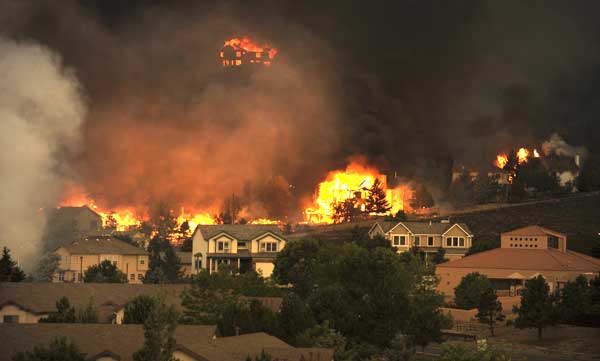
The folks in Duluth and Colorado are not the only ones picking up the tab. According to the National Oceanic and Atmospheric Administration, there were 14 weather and climate disasters in 2011 each totaling more than $1 billion in damage.
Insurance companies, which have to adjust our premiums to cover those losses, are well aware of the economic impact climate change is exerting.
“From our industry’s perspective, the footprints of climate change are around us and the trend of increasing damage to property and threat to lives is clear,” said Franklin Nutter, president of the Reinsurance Association of America. “We need a national policy related to climate and weather.”
More precisely, we need a policy that will end our addiction to fossil fuels.
But how do we de-tox without administering a fatal shock to our economic system?
Carbon Fee and Dividend: Market-Based Approach for Pricing Coal and Oil
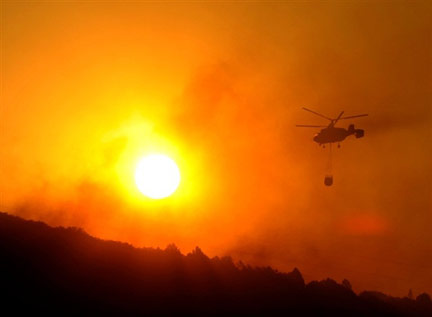

We can do that with a revenue-neutral price on fossil fuels known as carbon fee and dividend. A gradually increasing fee is placed on carbon-based fuels. The fee would increase each year, sending a price signal to private investors that wind, solar and geothermal will be more profitable than coal and oil. This market-based approach — a market in which the hidden costs of fossil fuels are accounted for — will spur a rapid transition to clean energy and energy efficiency.
Where does the dividend come in?
The money from the carbon fee is returned to the American people in per-capita shares, thereby offsetting the increased cost of energy associated with the fee. Border adjustments can be made on goods from nations that do not have equivalent carbon pricing.
Last fall, the International Energy Agency warned that we have only five years before we lock in the carbon-intensive infrastructure that will make the process of global warming irreversible. Given what’s at stake, it’s time for last call at Club Fossil Fuel.
Mark Reynolds is Executive Director of Citizens Climate Lobby
Updated 4 January 2018



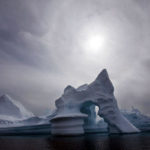


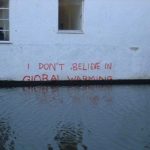






Excuse me, but global warming (or any form of climate change) can not cause increased rainfall and decreased rainfall simultaneously.
Global warming equals higher temperatures (June broke or tied 3,215 high-temperature records across the United States). From Bill McKibben: Meteorologists reported that this spring was the warmest ever recorded for our nation – in fact, it crushed the old record by so much that it represented the “largest temperature departure from average of any season on record.” The same week, Saudi authorities reported that it had rained in Mecca despite a temperature of 109 degrees, the hottest downpour in the planet’s history.
Warm air holds more water vapor than cold, so the atmosphere over oceans is over 5 percent wetter than average. This translates to some areas getting wetter, while simultaneously other areas, being hotter, become drier. This year the jet stream has tended far far north of average, which has reduced rainfall all across the southern two-thirds of the US. North of that line, haywire weather has been present, such as the freak storms in Duluth.
See the Bill McKibben article in Rolling Stone: http://www.rollingstone.com/politics/news/global-warmings-terrifying-new-math-20120719
Pingback: Jumpstart a Clean Energy Economy and Cool the Climate | WilderUtopia.com
Pingback: Amazon Rainforest Wilt: Long-Term Impacts from Drought | WilderUtopia.com